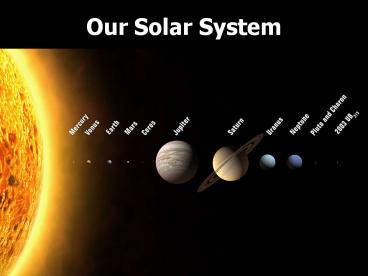Our Solar System - PowerPoint PPT Presentation
1 / 15
Title:
Our Solar System
Description:
1 Moon: 'Luna' where we have landed multiple times and sent more than 70 spacecraft. Earth's Moon 'Luna' The moon acts like a mirror; it reflects sunlight to Earth ... – PowerPoint PPT presentation
Number of Views:12
Avg rating:3.0/5.0
Title: Our Solar System
1
Our Solar System
2
The Sun
- It is a medium-sized yellow star in the middle of
its life cycle. - Its the center of our Solar System and holds
objects in orbit by gravity - More than 1,000,000 Earths can fit inside the Sun
- The only source of energy, its fueled by nuclear
fusion of small atoms to form larger ones - Has sun spots, solar flares, and prominences
3
Mercury
- Terrestrial planet with a solid rocky surface
- Covered with craters
- Extreme temperatures (from -170 ºC up to 467 ºC)
- Thin atmosphere so its temperatures vary by day
and night - Fastest planet to revolve around the Sun, thus
named Mercury - No moons
4
Venus
- Terrestrial planet with a solid, rocky surface
- Earths twin in size
- Extremely hot temperatures (470 ºC) due to thick
atmospheric cloud cover and green house effect. - Retrograde motion (it rotates clockwise)
- No moons
5
Earth
- Terrestrial planet with a solid, rocky surface
- Frozen caps at North South Poles
- Capable of supporting life due to C, 70 water,
and protective atmosphere - Seasons due to axis tilt
- 1 Moon Luna where we have landed multiple
times and sent more than 70 spacecraft
6
Earths Moon Luna
- The moon acts like a mirror it reflects sunlight
to Earth - Phases of the moon occur as the moon revolves
around Earth and reflects sunlight. - Tides -- high tide and low tide -- are caused by
the moons gravitational pull
7
Mars
- Terrestrial planet with a solid, rocky surface
- Red surface due to Fe
- Enormous active volcanoes and dust storms
- Thin atmosphere
- Frozen polar caps like Earth
- Liquid water once?
- 2 Moons Phobos and Deimos
8
Asteroids
- Made of rock, minerals, and rare elements
- More than 100,000 orbit in the Asteroid Belt
between Mars and Jupiter - Could collide with Earth, but probably wont
- One asteroid named Ceres is a dwarf planet
- Moons a few asteroids have moons
9
Meteors or Shooting Stars
- Pieces of rock that are falling toward Earth are
meteors - They glow brightly as they are burning up due to
fluid friction - Called meteoroids if they are far away,
meteors if they have a bright tail, and
meteorites once they hit Earth
10
Jupiter
- The largest gas giant with no solid surface
- Faint rings
- Made of elements H and He with a hot, solid
core of Fe -- almost a star! - Red Spot is a massive storm
- 62 Moons the four largest are named Io, Europa,
Ganymede, Callisto, but there are more
11
Saturn
- Second largest gas giant without a solid surface
- Famous for bright, icy rings that we can see from
Earth with a telescope. The rings have large
divisions. - Mostly made of elements H and He
- Less dense than water!
- 60 Moons Titan and Pheobe and more, some orbit
in the gaps of the rings
12
Uranus
- Gas giant without a solid surface
- Made of elements (H) and (He) and water, ammonia
and methane - Bluish reflection due to methan (CH4) gas
- Faint rings, but the brightest clouds
- Axis is turned sideways so it has wild seasons
- Retrograde motion
- 27 Moons Ariel and more
13
Neptune
- Gas giant without a solid surface
- Bluish reflection due to methane (CH4) gas but
more vivid than Uranus - Six faint rings
- Farthest planet from the Sun, usually
- 13 Moons Triton is the largest and 12 more
14
Dwarf Planets
- Pluto has a solid, icy surface, three moons,
and it orbits in a tilted plane. Charon is one
of 3 moons of Pluto. - Makemake is ¾ the size of Pluto and takes 310
years to orbit the sun. - Eris is larger than Pluto, but farther away
- More dwarf planets are expected to be named or
discovered
15
Comets
- Made of rock, ice and dust
- Comets consist of a head, coma, and two tails
that point away from the Sun - Short-period comets come from the Kuiper Belt
and orbit the Sun every 200 years or less - Long-period comets come from the Oort Cloud and
take longer to orbit the Sun































